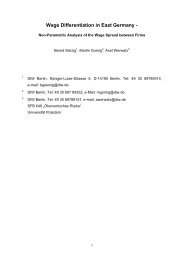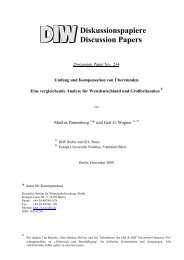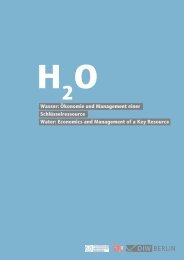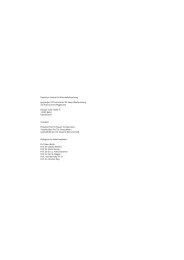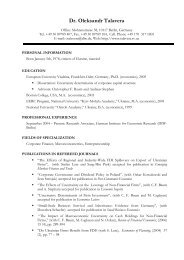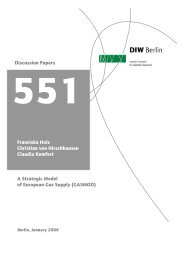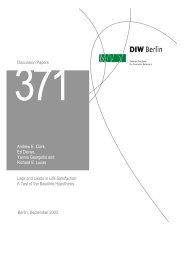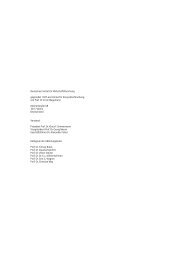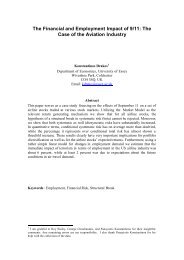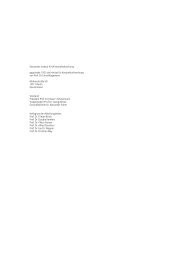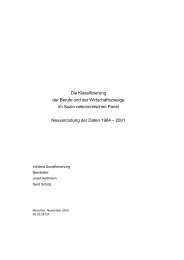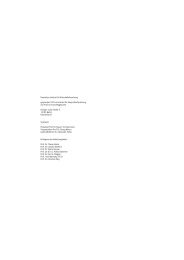Holger Görg and Frederic Warzynski Price cost margins ... - DIW Berlin
Holger Görg and Frederic Warzynski Price cost margins ... - DIW Berlin
Holger Görg and Frederic Warzynski Price cost margins ... - DIW Berlin
Create successful ePaper yourself
Turn your PDF publications into a flip-book with our unique Google optimized e-Paper software.
3 Dataset<br />
The analysis is based on company level data taken from the OneSource<br />
database which is compiled by OneSource Information Services Ltd. 5 The<br />
OneSource database is a subset of all actively trading companies which are<br />
legally required to deposit company accounts data at Companies House. It<br />
includes information on the top 110,000 private <strong>and</strong> public companies in all<br />
industries (not just manufacturing) in the United Kingdom. Specifically,<br />
the data include (i) all plcs, (ii) all companies with employment greater than<br />
50, (iii) the top companies based on turnover, net worth, total assets, or<br />
shareholders’ funds (whichever is the largest), up to a maximum of 110,000<br />
companies (Hart <strong>and</strong> Oulton, 1995).<br />
This dataset is particularly suitable for our purposes as it is one of the few<br />
datasets to contain recent firm level data on exports. 6 Also, it provides recent<br />
firm level data on, inter alia, output, employment, physical capital, wages<br />
<strong>and</strong> accounting data in a consistent way across firms in the UK. Furthermore,<br />
it has a time series element allowing investigation of the development of price<br />
<strong>cost</strong> <strong>margins</strong> over time. The data available to us cover the period 1990 to<br />
1996.<br />
Since the purpose of this study is to look at the relationship between<br />
exporting <strong>and</strong> price-<strong>cost</strong> <strong>margins</strong> we focus on private manufacturing firms<br />
only, dropping all public or non-manufacturing firms from the sample. We<br />
also drop firms that were ultimate holding companies or subsidiaries under<br />
joint ownership, 7 firms that have average employment or turnover levels of<br />
zero, or growth rates for wages or turnover of more than 200 percent or less<br />
than -200 percent in the data, <strong>and</strong> firms for which the ownership indicator<br />
(which indicates whether the firm is private/public owned, whether it is<br />
independent etc) is missing. Furthermore, in order to mitigate the impact<br />
of outliers in the regressions we excluded the top <strong>and</strong> bottom 5 percentile<br />
observations in terms of ∆yit <strong>and</strong> ∆xit.<br />
5 We used the OneSource CD-ROM entitled ”UK Companies, Vol. 1” for May 1998.<br />
See, for example, Girma et al. (2003) <strong>and</strong> Hart <strong>and</strong> Oulton (1996) for other papers<br />
using other vintages of the same database. Hart <strong>and</strong> Oulton (1995) provide a thorough<br />
description <strong>and</strong> discussion of the dataset.<br />
6 Note that micro level data on exporting are not available in the ARD database, the<br />
micro-level database provided by the Office for National Statistics (ONS) in the UK.<br />
7 These were dropped as it may lead to double counting if firms have consolidated<br />
accounts.<br />
8



